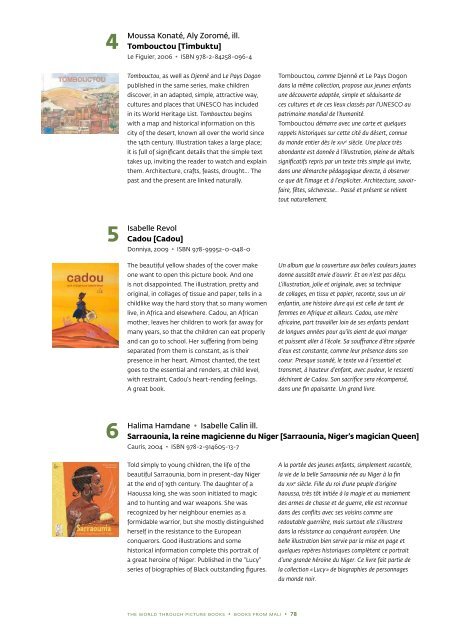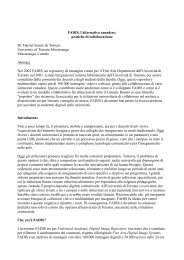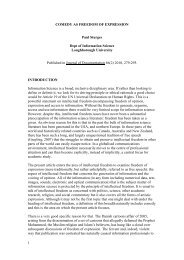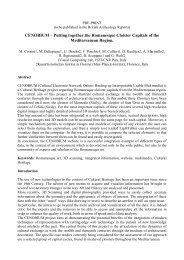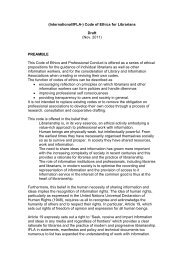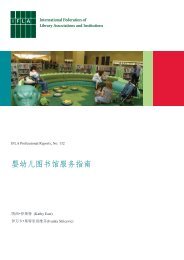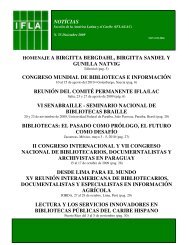English - IFLA
English - IFLA
English - IFLA
You also want an ePaper? Increase the reach of your titles
YUMPU automatically turns print PDFs into web optimized ePapers that Google loves.
4<br />
5<br />
6<br />
Moussa Konaté, Aly Zoromé, ill.<br />
Tombouctou [Timbuktu]<br />
Le Figuier, 2006 • ISBN 978-2-84258-096-4<br />
Tombouctou, as well as Djenné and Le Pays Dogon<br />
published in the same series, make children<br />
discover, in an adapted, simple, attractive way,<br />
cultures and places that UNESCO has included<br />
in its World Heritage List. Tombouctou begins<br />
with a map and historical information on this<br />
city of the desert, known all over the world since<br />
the 14th century. Illustration takes a large place;<br />
it is full of significant details that the simple text<br />
takes up, inviting the reader to watch and explain<br />
them. Architecture, crafts, feasts, drought… The<br />
past and the present are linked naturally.<br />
Isabelle Revol<br />
Cadou [Cadou]<br />
Donniya, 2009 • ISBN 978-99952-0-048-0<br />
The beautiful yellow shades of the cover make<br />
one want to open this picture book. And one<br />
is not disappointed. The illustration, pretty and<br />
original, in collages of tissue and paper, tells in a<br />
childlike way the hard story that so many women<br />
live, in Africa and elsewhere. Cadou, an African<br />
mother, leaves her children to work far away for<br />
many years, so that the children can eat properly<br />
and can go to school. Her suffering from being<br />
separated from them is constant, as is their<br />
presence in her heart. Almost chanted, the text<br />
goes to the essential and renders, at child level,<br />
with restraint, Cadou’s heart-rending feelings.<br />
A great book.<br />
Told simply to young children, the life of the<br />
beautiful Sarraounia, born in present-day Niger<br />
at the end of 19th century. The daughter of a<br />
Haoussa king, she was soon initiated to magic<br />
and to hunting and war weapons. She was<br />
recognized by her neighbour enemies as a<br />
formidable warrior, but she mostly distinguished<br />
herself in the resistance to the European<br />
conquerors. Good illustrations and some<br />
historical information complete this portrait of<br />
a great heroine of Niger. Published in the “Lucy”<br />
series of biographies of Black outstanding figures.<br />
the world through picture books • books from mali • 78<br />
Tombouctou, comme Djenné et Le Pays Dogon<br />
dans la même collection, propose aux jeunes enfants<br />
une découverte adaptée, simple et séduisante de<br />
ces cultures et de ces lieux classés par l’UNESCO au<br />
patrimoine mondial de l’humanité.<br />
Tombouctou démarre avec une carte et quelques<br />
rappels historiques sur cette cité du désert, connue<br />
du monde entier dès le xive siècle. Une place très<br />
abondante est donnée à l’illustration, pleine de détails<br />
significatifs repris par un texte très simple qui invite,<br />
dans une démarche pédagogique directe, à observer<br />
ce que dit l’image et à l’expliciter. Architecture, savoirfaire,<br />
fêtes, sécheresse... Passé et présent se relient<br />
tout naturellement.<br />
Un album que la couverture aux belles couleurs jaunes<br />
donne aussitôt envie d’ouvrir. Et on n’est pas déçu.<br />
L’illustration, jolie et originale, avec sa technique<br />
de collages, en tissu et papier, raconte, sous un air<br />
enfantin, une histoire dure qui est celle de tant de<br />
femmes en Afrique et ailleurs. Cadou, une mère<br />
africaine, part travailler loin de ses enfants pendant<br />
de longues années pour qu’ils aient de quoi manger<br />
et puissent aller à l’école. Sa souffrance d’être séparée<br />
d’eux est constante, comme leur présence dans son<br />
coeur. Presque scandé, le texte va à l’essentiel et<br />
transmet, à hauteur d’enfant, avec pudeur, le ressenti<br />
déchirant de Cadou. Son sacrifice sera récompensé,<br />
dans une fin apaisante. Un grand livre.<br />
Halima Hamdane • Isabelle Calin ill.<br />
Sarraounia, la reine magicienne du Niger [Sarraounia, Niger’s magician Queen]<br />
Cauris, 2004 • ISBN 978-2-914605-13-7<br />
A la portée des jeunes enfants, simplement racontée,<br />
la vie de la belle Sarraounia née au Niger à la fin<br />
du xixe siècle. Fille du roi d’une peuple d’origine<br />
haoussa, très tôt initiée à la magie et au maniement<br />
des armes de chasse et de guerre, elle est reconnue<br />
dans des conflits avec ses voisins comme une<br />
redoutable guerrière, mais surtout elle s’illustrera<br />
dans la résistance au conquérant européen. Une<br />
belle illustration bien servie par la mise en page et<br />
quelques repères historiques complètent ce portrait<br />
d’une grande héroïne du Niger. Ce livre fait partie de<br />
la collection « Lucy » de biographies de personnages<br />
du monde noir.<br />
7<br />
8<br />
9<br />
Marlène Anna Amegankpoé • Svetlana Amegankpoé, ill.<br />
Petit Poussin veut… grandir [Little Chicken wants… to grow up]<br />
Donniya, 2009 • ISBN 99952-0-054-6<br />
A picture book on an universal question: every<br />
child’s wish to grow up and surpass his father<br />
or his mother. This is Little Chick’s wish. He’ll<br />
have to endure some setbacks before learning<br />
patience and finding himself, one day, almost as<br />
beautiful as his father. Svetlana Amegankpoé’s<br />
humoristic drawings show a terribly expressive<br />
chicken – curious, tender, ridiculous, sad or<br />
impatient. Images are as colourful as a backyard<br />
poultry, as joyous and lively as the story.<br />
Ousmane Diarra • Massaré Tounkara, ill.<br />
La Princesse capricieuse [The Capricious Princess]<br />
Balani’s, 2006<br />
A version of the well-known story of the girl<br />
who puts an impossible condition on her<br />
marriage. This time, it is because she likes<br />
money too much and wishes to get rich thanks<br />
to her suitors… The man she marries is in fact<br />
a python, but with the help of her sister who<br />
has witch powers she escapes her husband and<br />
goes back home. The text by Ousmane Diarra,<br />
writer and storyteller, flows nicely; expressive,<br />
colourful illustrations are as lively as the text.<br />
The story is told in French and in Bambara in<br />
the accompanying audio cassette.<br />
The protective and affectionate relationship<br />
between a young boy and his toddler brother.<br />
A brief, simple text; illustration – somewhat<br />
clumsy and naïve, but with a certain charm –<br />
stages the two boys in a relationship of play and<br />
laughter but also of “education” that works well<br />
beyond language. And to grow up, nothing better<br />
than good stories… The Father is kindly asked to<br />
bring back, from Bamako market…picture books!<br />
Links between children are finely depicted, and<br />
the message is touching and lively. Some small<br />
punctuation and orthographic problems are to<br />
be regretted.<br />
the world through picture books • books from mali • 79<br />
Cet album nous offre l’histoire d’un problème universel :<br />
le désir que tout enfant nourrit de devenir grand sur<br />
le champ et de surpasser son père ou sa mère. C’est<br />
aussi le souhait de Petit Poussin. Il lui faudra essuyer<br />
quelques déconvenues avant d’apprendre la patience<br />
pour se découvrir enfin, le jour venu, presque aussi<br />
beau que son coq de père. Le dessin humoristique<br />
de Svetlana Amegankpoé nous offre un poussin<br />
terriblement expressif – tour à tour curieux, tendre,<br />
ridicule, triste ou impatient. Le dessin est coloré,<br />
à l’image de la basse-cour, gai et enlevé, comme<br />
cette histoire.<br />
Une version du conte bien connu de la jeune fille<br />
qui met une condition impossible à son mariage.<br />
Cette fois-ci, parce qu’elle aime trop l’argent et veut<br />
s’enrichir sur le dos des prétendants… L’être qu’elle<br />
épouse finalement se révèle être un python, et<br />
ce n’est qu’avec l’aide de sa petite sœur qui a des<br />
pouvoirs de sorcière qu’elle échappera à son mari<br />
et retournera chez elle. Le texte d’Ousmane Diarra,<br />
écrivain et conteur, coule avec la fluidité de sa parole ;<br />
les illustrations expressives, colorées, soulignent la<br />
vivacité du texte. Le texte est raconté en français<br />
et en bambara dans une cassette audio.<br />
Moulaye et Zakaria Traoré • Nafogo Coulibaly, ill. • Ismaïla Samba Traoré, adapt.<br />
Nabi mon frère<br />
La Sahélienne, 2010 • ISBN 978-99952-54-14-8<br />
All book reviews are adapted from those published in the journal Takam Tikou,<br />
http://takamtikou.bnf.fr<br />
La relation protectrice et affectueuse d’un garçonnet<br />
envers un petit frère qui tient tout juste sur ses<br />
jambes. Un texte court, simple ; des illustrations dont<br />
la maladresse et la naïveté ne sont pas dénuées d’un<br />
charme particulier, met en scène les deux enfants dans<br />
une relation de jeu, de rire, mais aussi d’ « éducation »,<br />
qui passe bien au-delà du langage. Et pour grandir,<br />
quoi de mieux que de belles histoires à écouter ? Le père<br />
est ainsi gentiment sommé, lorsqu’il ira au marché<br />
de Bamako, de rapporter des livres avec des images !<br />
Une juste observation en finesse des liens entre<br />
enfants et un message touchant et plein de vitalité.<br />
Dommage pour les petits problèmes de ponctuation<br />
et d’orthographe...


